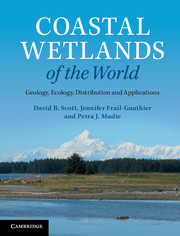Book contents
- Frontmatter
- Contents
- Preface
- List of acronyms and abbreviations
- 1 Introduction: what is covered in this coastal wetlands book?
- 2 Physical aspects: geological, oceanic and climatic conditions
- 3 Zonations and plants: development, stressors and adaptations
- 4 Animals in coastal wetlands: zonation, adaptations and energy flow
- 5 Human intervention causing coastal problems
- 6 Coastal wetlands worldwide: climatic zonation, ecosystems and biogeography
- 7 Examples of North American salt marshes and coastal wetlands
- 8 Examples of South American coastal wetlands
- 9 Africa: selected marsh and mangrove areas
- 10 Europe and Asia: a view of what remains
- 11 Australasia: wetlands of Australia and New Zealand
- 12 Applications in geological monitoring: paleoseismology and paleoclimatology
- 13 Applications in conservation of plant biodiversity and agriculture
- 14 Using mesocosms as a way to study coastal wetlands
- 15 Conclusions and future directions
- References
- Index
- Plate section
11 - Australasia: wetlands of Australia and New Zealand
Published online by Cambridge University Press: 05 July 2014
- Frontmatter
- Contents
- Preface
- List of acronyms and abbreviations
- 1 Introduction: what is covered in this coastal wetlands book?
- 2 Physical aspects: geological, oceanic and climatic conditions
- 3 Zonations and plants: development, stressors and adaptations
- 4 Animals in coastal wetlands: zonation, adaptations and energy flow
- 5 Human intervention causing coastal problems
- 6 Coastal wetlands worldwide: climatic zonation, ecosystems and biogeography
- 7 Examples of North American salt marshes and coastal wetlands
- 8 Examples of South American coastal wetlands
- 9 Africa: selected marsh and mangrove areas
- 10 Europe and Asia: a view of what remains
- 11 Australasia: wetlands of Australia and New Zealand
- 12 Applications in geological monitoring: paleoseismology and paleoclimatology
- 13 Applications in conservation of plant biodiversity and agriculture
- 14 Using mesocosms as a way to study coastal wetlands
- 15 Conclusions and future directions
- References
- Index
- Plate section
Summary
Key points
Australia and New Zealand are in the Oceania biogeographic realm; regional wetland variations reflect different bedrock types, and tidal and wave regimes; Australia is tectonically stable, with a wide spectrum of climates, many estuaries and unique inland ‘billabongs’; mangroves are similar to the Indonesian islands that were connected by Ice-Age land bridges; lack of Australian icesheets means the history of sea level change is different; there are four coastal wetlands types: Barrier Reef mangroves, northern mudflat mangroves, giant stromatolite carbonate bioherms and sandy headlands with the world’s southernmost mangroves; New Zealand is a tectonically active part of the ‘Pacific Ring of Fire’, with volcanoes and frequent earthquakes; it has cool-temperate salt marshes and shrubby mangroves; one of the last Pacific regions to be colonized by humans, New Zealand has already lost 90% of its wetlands.
In this chapter, we review the salient features of the coastal wetlands in the continent of Australia and the islands of New Zealand (Figure 11.1), both of which are in the Ramsar Oceania biogeographic region (Figure 6.1). Australia is the smallest of the world’s continents, but it covers a large latitudinal range, stretching from 11° S of the Equator to the edge of the cool temperate climate region at ~44° S; its coastline includes many estuarine areas (Figure 11.1), although it has no large deltas in serious danger of destruction by rising sea level. New Zealand is a much smaller country, extending from ~35 to 48° S; it is one of the last of the Pacific regions to be colonized by humans, but already has lost 90% of its wetlands (Mitsch and Gosselink, 2007; Silliman et al., 2009). Southern Australia and New Zealand North Island have the southernmost of the world’s mangroves, but these countries differ greatly in climate and tectonic setting. Australia has the world’s oldest rocks, which largely have been tectonically stable for >65 million years, whereas New Zealand is part of the Polynesian active ‘Ring of Fire’. The two Australasian subregions are therefore discussed separately in this book.
- Type
- Chapter
- Information
- Coastal Wetlands of the WorldGeology, Ecology, Distribution and Applications, pp. 231 - 247Publisher: Cambridge University PressPrint publication year: 2014



